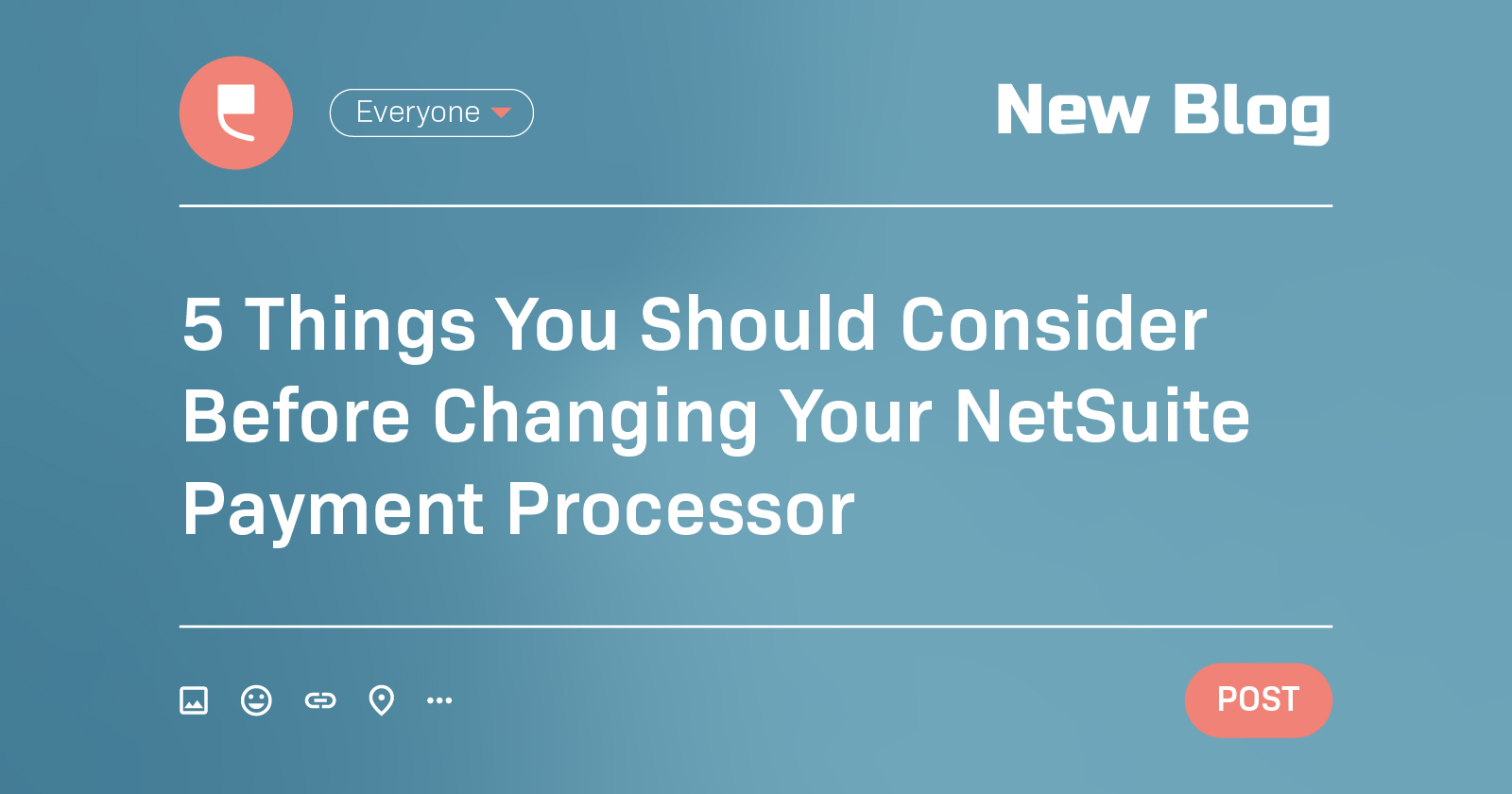If you’re considering changing your NetSuite payment processor, you aren’t alone.
According to a PYMNTS study, fifty-nine percent of small to mid-sized businesses (SMBs) said they would consider switching for lower transaction fees. Additionally, nearly fifty percent said that a more usable processor would seal the deal.
No matter the reason for changing your NetSuite payment processor, it’s important to start the process well prepared. Here are five key things to consider before making the switch.
Step #1: Determine Why You Want to Change Processors
It’s integral to be clear on why you’re making the shift, as it takes time to implement the new processor, train staff on the changes, and optimize the process.
For example, do you want to reduce transaction costs to create a healthier cash flow? Are you releasing a new product that would work better with a recurring pricing structure?
Some common reasons to shift from your current payment processor include:
- Poor customer experience
- High transaction costs and hidden fees
- Lengthy contracts
- Poor integrations
- Minimal features
Once the reason for the change is established, it’s much easier to evaluate new programs against your business needs and set relevant key performance indicators (KPIs) to manage overall success.
Additionally, being able to explain why you are changing processors to your internal team will help with adoption. When those on your team feel left in the dark about why a major change is happening, oftentimes, they may look at the change in a negative light rather than see the benefits.
Step #2: Map Your Business Needs and Goals
Once you have your why, it’s time to map your business needs and goals.
There are a few essential areas where changing your payment processor will have the most impact:
- Transaction Volume and Types: Different processors may offer better rates or features for specific transaction types (ACH, debit, types of credit cards accepted, Level 2 and 3 data for business transactions all attribute to the percentage of fees you will be charged). It’s important to determine your average transaction volume and the types of transactions you see most used by your customers. This can include subscription payments, loyalty points, or accepting alternative payment methods.
- Industry Specifications: Industries like hospitality or healthcare require unique payment processing features and compliance measures. These requirements make it even more important to find a high-quality processor. Ideally, your selected solution will be an expert in that field and will already cater to your industry needs. Another consideration is customization—how much flexibility does your payment processor’s platform provide?
- Scalability: Another key factor is how your payment processor fits your long-term goals. What features might you need in the future? How does increased transaction volume affect your overall fees? Will your payment partner be able to grow with you as you scale?
- Usability in NetSuite: The payment platform must work well within your ERP software, NetSuite. Integrated NetSuite partners provide a better fit, as these solutions are built for NetSuite, making the integration and maintenance seamless.
Step #3: Focus on Costs and Fee Structures
Evaluating cost and fee structures is critical when considering new payment processors.
You’ll want to ask the following questions to determine if a processor is a good fit:
- What type of fees are charged (pre-transaction fees, interchange fees, etc.)?
- Does the processor offer interchange optimization?
- Are fees subscription-based?
- Are there any hidden fees or additional charges in the contract?
- How does the processor leverage chargeback fees?
- Do they have automated Level 2 and 3 processing?
It’s important to note that these terms may not be set in stone. Many payment processors are open to negotiation on fee structure. Some even offer customized packages based on transaction volume.
Step #4: Invest in Security and Compliance
Payment data is highly sensitive, and the fallout from a breach can be devastating. Security is a non-negotiable.
Whatever payment processor you select should be 100% compliant with the Payment Card Industry Data Security Standard (PCI-DSS). Ideally, your solution should also use data encryption and tokenization to safeguard customer data, as well as, 3D Secure as an added level of security for transactions.
Another important aspect is fraud prevention. A strong payment processor candidate should have extensive fraud prevention measures and tools.
Step #5: Make Sure You’re Integrated and Your Team is Aligned
Finally, you’ll want to take time to ensure that your payment processor can integrate with all software that exists in your ecosystem. This includes shopping carts, accounting software, and in this case, NetSuite.
It is also critical to have your staff understand the new system during the implementation process. In regard to ISVs, it’s important to have training modules for customers if they will be able to adjust payment settings.
A lack of knowledge is one of the biggest challenges for any kind of digital transformation, so providing educational resources can ensure success. Best-in-class payment processors often have training or documentation materials and offer training sessions for your team.
Discover a Better Way to Process Payments in NetSuite
Changing payment processors is a strategic move. Rather than draining resources and time from your organization, it can accelerate growth and free up revenue. But it’s important to pick the right partner for your business. Consider the five steps above when choosing a new payment processor in NetSuite.




